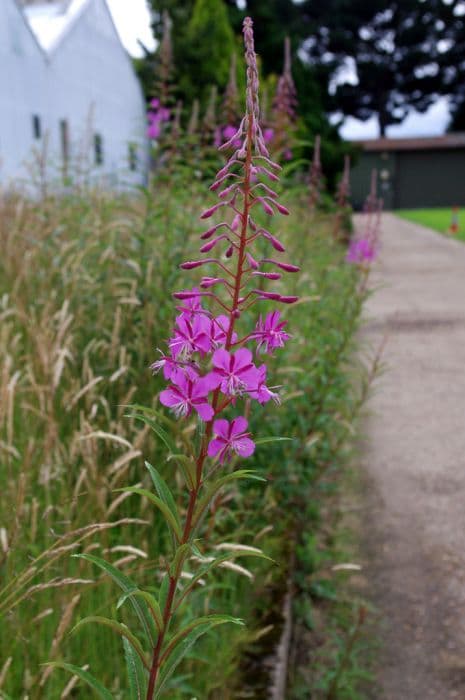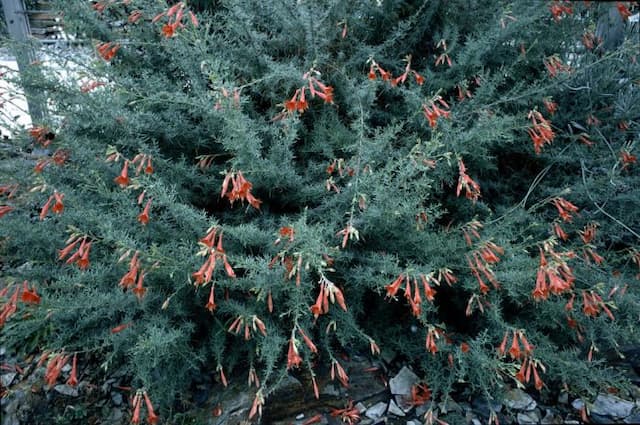Variegated Hardy Fuchsia Fuchsia magellanica var. gracilis 'Versicolor' (v)

ABOUT
Fuchsia 'Versicolor', often just called fuchsia, is a particularly striking variety with an elegant appearance that captures attention in any garden setting. The most distinctive feature of this plant is its foliage, which possesses a variegated pattern combining a soft green with creamy-white and sometimes pinkish edges, adding a delicate contrast and color play to the leaves. The fuchsia 'Versicolor' blooms prolifically, producing exquisite pendant flowers that dangle gracefully from the branches. The blossoms have a unique two-tone look, with the outer petals usually being a vibrant purple or pink shade, while the inner, skirt-like petals are a paler pink or sometimes white. The flowers are long and tubular, with the outer petals flaring back elegantly to reveal the softer interior, looking almost like a dancer's twirling skirt. The long, protruding stamens and pistil add a whimsical touch, often in a contrasting hue, and can catch the eye from a distance. Adding to the ornamental value, the plant's soft woody stems can sometimes show a reddish or purplish tint, contributing further to the overall color palette of the plant. The fuchsia 'Versicolor' offers a blend of lush, variegated foliage and spectacular, colorful flowers that together create a stunning visual display. Its appearance evokes an air of tropical elegance, although it is adaptable to various climate settings. The fuchsia 'Versicolor' is a plant that brings both foliage and floral beauty to the table, with its variegated leaves offering year-round interest and the dangling flowers providing a seasonal show that can charm onlookers and encourage pollinators to visit the garden. It is as much an ornamental delight as it is a cornerstone for biodiversity.
About this plant
 Names
NamesFamily
Onagraceae
Synonyms
Hummingbird Fuchsia, Hardy Fuchsia, Lady's Eardrops
Common names
Fuchsia magellanica var. gracilis 'Tricolor', Fuchsia magellanica var. gracilis 'Variegata'.
 Toxicity
ToxicityTo humans
The plant commonly known as Hardy Fuchsia is generally considered non-toxic to humans. There are no well-documented cases of poisoning from ingesting parts of this plant, and it does not usually cause adverse reactions when handled. As with any plant, individuals may have varying sensitivities, so it is always good practice to avoid ingesting parts of ornamental plants unless they are known to be edible.
To pets
The Hardy Fuchsia is also generally considered non-toxic to pets. There is no widespread evidence of this plant causing poisoning in pets such as dogs and cats. However, individual animals might experience mild gastrointestinal upset if they ingest large quantities of the plant, and different animals can have varied levels of sensitivity. Monitoring your pets and preventing them from eating non-food plants is always a good precaution.
 Characteristics
CharacteristicsLife cycle
Perennials
Foliage type
Deciduous
Color of leaves
Variegated
Flower color
Mixed
Height
4-5 feet (1.2-1.5 meters)
Spread
4-5 feet (1.2-1.5 meters)
Plant type
Shrub
Hardiness zones
6-9
Native area
Southern Chile
Benefits
 General Benefits
General Benefits- Ornamental Value - The variegated foliage and vibrant hanging flowers add color and visual interest to gardens.
- Attracts Pollinators - It is known to attract hummingbirds, bees, and other pollinators, supporting local ecosystems.
- Long Blooming Season - The plant flowers from early summer to the first frosts, providing extended beauty in the garden.
- Shade Tolerance - It can tolerate partial shade, making it versatile for different garden locations.
- Easy Propagation - It can be easily propagated by cuttings, allowing gardeners to multiply their plants.
- Low Maintenance - Once established, it requires minimal care apart from occasional pruning to maintain shape.
- Boundary Planting - It can be used for borders and hedging, providing structure to garden design.
- Container Gardening - Suitable for pots and containers, it is ideal for patios, balconies, or small spaces.
- Cold Resistance - It is relatively hardy in cooler climates, within its growing zones.
 Medical Properties
Medical PropertiesThis plant is not used for medical purposes.
 Air-purifying Qualities
Air-purifying QualitiesThis plant is not specifically known for air purifying qualities.
 Other Uses
Other Uses- The variegated leaves of Fuchsia 'Versicolor' can be used in pressed flower art, where the leaves' unique colors can add an interesting design element.
- In photography, the distinctive appearance of Fuchsia 'Versicolor' can serve as a striking subject for macro photography practices.
- Fuchsia 'Versicolor' can be employed as a natural dye source, where the petals may provide interesting hues for fabric or paper dyeing projects.
- During educational activities, parts of the Fuchsia 'Versicolor', such as the flowers and fruits, can be used to demonstrate plant biology and botany concepts.
- This plant can be incorporated into culinary presentations as an edible garnish, with its flowers adding a splash of color to plates and desserts.
- Fuchsia 'Versicolor' can be utilized in crafting, where branches and flowers can be used to create natural wreaths and floral arrangements.
- As a companion plant in gardens, Fuchsia 'Versicolor' can help attract pollinators like bees and hummingbirds, benefiting the surrounding vegetation.
- In the practice of plant chromatography for educational purposes, the color components of Fuchsia 'Versicolor' may be separated to show the individual pigments.
- In floral language and symbolism studies, Fuchsia 'Versicolor' can represent confiding love and be used as a tool to convey specific sentiments in floriography.
- The fuchsia can be used in fashion design, inspiring textile patterns and prints with its striking colors and organic forms.
Interesting Facts
 Feng Shui
Feng ShuiThe Hardy Fuchsia is not used in Feng Shui practice.
 Zodiac Sign Compitability
Zodiac Sign CompitabilityThe Hardy Fuchsia is not used in astrology practice.
 Plant Symbolism
Plant Symbolism- Confidence - The vibrant colors of the Fuchsia plant symbolize confidence and boldness, encouraging individuals to trust their instincts.
- Elegance - Fuchsia's delicate, hanging blossoms represent grace and sophistication, making it a symbol of elegance in the plant world.
- Tastefulness - With its unique variegated foliage, Fuchsia signifies a tasteful sense of style and a love for aesthetic beauty.
- Amiability - Known for its friendly and inviting appearance, the Fuchsia plant is often associated with warm hospitality and kindness.
- Intuition - The complex structure of the Fuchsia flowers can represent intuition and inner wisdom, suggesting a connection to the subconscious mind.
 Water
WaterThe Fuchsia 'Versicolor' prefers consistently moist soil, so water when the top inch of soil feels dry to the touch. Depending on the weather and soil drainage, this often equates to watering once or twice a week. Ensure you apply water directly to the soil rather than overhead to avoid wetting the foliage, which can lead to fungal diseases. During hot summer months, you may need to water more frequently, keeping an eye on the soil moisture level. Typically, you should provide about 1 gallon of water for an outdoor plant of moderate size at each watering session, less for smaller plants or potted specimens.
 Light
LightThe Fuchsia 'Versicolor' thrives in partial shade to filtered sunlight, avoiding the intense midday sun which can scorch its leaves. The plant does best in a location where it receives morning sunlight and afternoon shade or dappled sunlight throughout the day. A north-facing or east-facing spot is ideal, providing the bright but indirect light conditions it needs to flourish.
 Temperature
TemperatureFuchsia 'Versicolor' prefers cooler temperatures and can tolerate a range down to about 40 degrees Fahrenheit without damage. Ideal growing temperatures are between 60 to 70 degrees Fahrenheit. It’s important to protect the plant from temperatures above 80 degrees Fahrenheit, which can stress the plant and cause flower drop.
 Pruning
PruningPrune Fuchsia 'Versicolor' in the spring to maintain plant shape and encourage bushier growth. Deadheading throughout the growing season also promotes further blooming. Major pruning should be done before the new growth starts, but light pruning can be done any time as needed to remove dead or damaged wood and to aestheticize the plant.
 Cleaning
CleaningAs needed
 Soil
SoilThe best soil mix for Hardy Fuchsia (the most common name for Fuchsia magellanica var. gracilis 'Versicolor') is a well-draining, loamy potting mix with peat moss, perlite, and compost. The ideal soil pH for Hardy Fuchsia is slightly acidic, between 6.0 and 7.0.
 Repotting
RepottingHardy Fuchsia should be repotted every two to three years to refresh the soil and accommodate root growth. It's best to repot in late winter or early spring before new growth begins.
 Humidity & Misting
Humidity & MistingHardy Fuchsia thrives best in a high humidity environment, ideally between 60% to 70%. Regular misting can help maintain these levels if the ambient humidity is not naturally sufficient.
 Suitable locations
Suitable locationsIndoor
Give bright indirect light, ensure high humidity, and protect from drafts for Hardy Fuchsia.
Outdoor
Plant in partial shade, shelter from wind, ensure well-draining soil for Hardy Fuchsia.
Hardiness zone
6-9 USDA
 Life cycle
Life cycleFuchsia 'Versicolor' begins its life cycle when the seeds germinate in spring, with the right combination of warmth and moisture. The seedlings emerge, establishing a root system and sprouting their first leaves, and as the plant grows, stems elongate and produce the characteristic green and cream variegated foliage. Throughout the spring and summer, it develops numerous drooping flowers, typically with a purple and pink hue, attracting pollinators for fertilization. After pollination, the flowers develop into small, dark-colored fruits containing seeds that can be dispersed to propagate the next generation. The plant continues to grow and can develop into a bushy shrub, being semi-hardy it may require some protection over winter in colder climates. With proper care, including pruning and sheltering from severe weather, Fuchsia 'Versicolor' can survive for several years, going dormant in the winter and re-sprouting in the subsequent spring.
 Propogation
PropogationPropogation time
Spring-Early Summer
Fuchsia magellanica var. gracilis 'Versicolor', commonly known as Hardy Fuchsia, is most commonly propagated through softwood cuttings. The optimal time to do this is in late spring to early summer. The procedure involves taking a 3 to 5 inch (approximately 7.5 to 12.5 cm) cutting from a healthy section of the plant, making the cut just below a leaf joint or node. The lower leaves are removed, and the cutting is dipped in rooting hormone powder to encourage root development. The prepared cutting is then inserted into a pot filled with a well-draining potting mix, ensuring at least two nodes are below the surface. Providing a warm environment and maintaining humidity by covering the pot with a plastic bag or placing it in a propagator can speed up the rooting process. It typically takes a few weeks for the cuttings to root, after which they can be transferred to individual pots to grow on.









